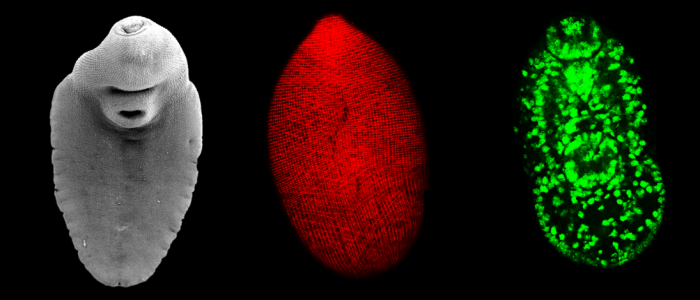Simone Häberlein

Institute of Parasitology
Biomedical Research Center Seltersberg (BFS)
Justus Liebig University Giessen
Schubertstr. 81
35392 Gießen
(website)
Simone Häberlein
...is a zoologist and molecular biologist with a true passion for parasitic flatworms. Her research focus is understanding their cell biology, their host-parasite interactions, and finding new drug candidates. After a diploma and PhD in biology at the University of Erlangen-Nürnberg and the University Clinic Erlangen, she went for a 3-year postdoc stay at the Leiden University Medical Center (The Netherlands). Simone’s previous research topics range from the identification of chemical cues that trigger parasites to enter their host, to epidemiological studies on insect vector distribution, the type of immune responses triggered by parasites, and how to employ these responses for treating allergy (the “hygiene hypothesis”). In 2016, she added molecular parasitology to her expertise repertoire by joining the group of Christoph Grevelding in the Institute of Parasitology, Justus Liebig University Giessen. Since 2022, Simone is a group leader with innovative projects in the fields of transcriptomics and biophysics of two parasitic flatworms, the liver fluke Fasciola hepatica and the blood fluke Schistosoma mansoni. Simone was honored by numerous research fellowships and received several awards for her achievements as a young investigator, including the Karl-Asmund-Rudolphi Medal of the German Society of Parasitology (DGP) in 2020.
Since 2022 Group leader for “Helminth Cell Biology and Biophysics”, JLU Giessen
2021 Habilitation in „Molecular Parasitology and Zoology”, JLU Giessen
2016-2022 Project leader (Wissenschaftliche Assistentin), JLU Giessen
2012-2015 PostDoc, Leiden University Medical Center, The Netherlands
2012 PostDoc, University Clinic, Erlangen
2011 PhD in Biology, University Erlangen-Nürnberg
Research synopsis
We have diverse research interests ranging from the study of parasite-host interactions at a biophysical level, understanding how cells in parasitic flatworms survive and differentiate, and how to make use of this knowledge to find novel therapeutics. To achieve these aims, our multidisciplinary lab combines the expertise of biologists, veterinarians, a bioinformatician, and a biophysicist. Alongside a focus on transcriptional regulators of parasite stem cells, we are pioneering the use of insects as an innovative natural source for antiparasitic drugs.
Our methods include single-cell transcriptomics to generate a flatworm cell atlas, RNA-based gene silencing in the parasites for identification of novel therapeutic targets, confocal laser scanning microscopy, and in vitro-culture systems of parasitic flatworms. By using traction force microscopy, we want to study the mechanical forces that parasitic flatworms exert on host tissues as part of Project 10 of the SPP 2332 PoP.






